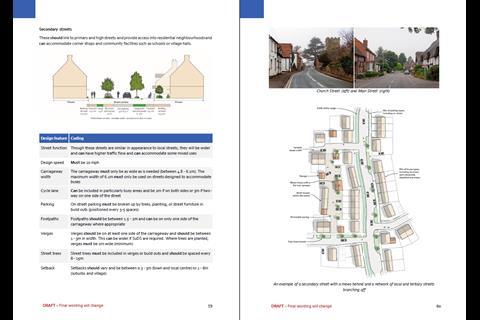Design codes are required because most house builders aren’t delivering good design. They work best when they’re simple and unambiguous, writes Robert Kwolek

You’ve probably been reading a lot about design codes in recent months. Articles about design codes looking at what they are, what they can accomplish and who’s working on them have cropped up both in this publication and others.
Most of the articles are quite theoretical, and little wonder as area-based design codes are still relatively new in the UK. They’ve been used for decades elsewhere, however, including in the US.
At Create Streets, my colleagues and I have been writing about and working on design codes for many years as well as supporting some of the earliest discussions leading to the National Model Design Code (NMDC). We now have a number of design codes ongoing for district councils, parish councils, landowners and developers.
While most architects won’t have run into them yet, they soon will. There’s already strong guidance within the National Planning Policy Framework urging councils to use design codes to set quality standards and Secretary of State Michael Gove reiterated the point in a letter to council leaders urging them to “prepare design codes now”. Councils will be required to do so if and when the Levelling Up bill passes Parliament.
In our experience, there seems to be some confusion about what the NMDC is. While the NMDC sets out a structure for design codes, it doesn’t tell you what the codes should be. Codes can be as flexible or prescriptive as local communities want, and this should be gauged by community engagement early in the process.
A design code must have a purpose to be worth the not-insignificant investment
That being said, design codes should have teeth. Codes should set clear requirements to which a design can clearly conform or not conform. Without “musts” and “shoulds”, a design code is merely a design guide – or not much different from what we have now which is clearly not working most of the time.
They should be clear with little resort to phrases such as “where appropriate” or other such vague language which could be interpreted a million different ways by a designer, developer, planning official or… planning KC. The design code should set out when something is appropriate or not and leave little room for interpretation.
Design codes should be strong in areas most important to local communities. This usually means being prescriptive about materials and locally distinctive features – the aspects which define a sense of place and give somewhere an identity and make them unique.
A design code must have a purpose to be worth the not-insignificant investment. They are normally most effective if you keep them as short, visual and numerical as possible.
While design codes will usually apply to all buildings, their primary purpose is to raise the standard of housing developments. They represent the majority of new buildings in most areas.
These are the buildings local residents tend to be most disappointed by and they’re the buildings design codes can tackle most effectively. Arguably, we wouldn’t even need design codes if more of the major housebuilders had cared more about design and quality, but, alas, that’s far from true.
A design code could mandate a purely traditional approach just as it could a purely contemporary approach
Some architects are worried design codes may close the door on creativity. Perhaps, if one’s definition of creativity is being able to do whatever one likes.
Most would agree, however, that the greatest creativity emerges when one has to work within constraints, and those will vary from place to place. Some places, like the Cotswolds, have a strong identity which local residents understandably want to preserve and even enhance, while other places may benefit from a more contemporary approach.
We should be ok with that difference in approach. A design code could mandate a purely traditional approach just as it could a purely contemporary approach.
Crucially, though, even a contemporary building can reflect a local character, a desire we’ve heard repeated in all the community engagement we’ve done. Most people don’t want buildings which look like they could be anywhere.
Personally, I’m quite excited to see how architects respond to the design codes we’re working on. For those who genuinely care about local communities’ preferences and aspirations, it could lead to thoughtful, contextual buildings which I hope both architects and local residents can enjoy.
For now, we’re still waiting for both our design codes and others to be adopted to see just how they’ll shake things up. Hopefully, at the very least, they raise the bar for design quality, support sociable and sustainable new neighbourhoods and result in places residents can be proud to call home.
Also read >> Will design codes help unlock the planning system?
Postscript
Robert Kwolek is a senior architectural designer at Create Streets and is working on a range of rural and urban design codes across England.


















1 Readers' comment